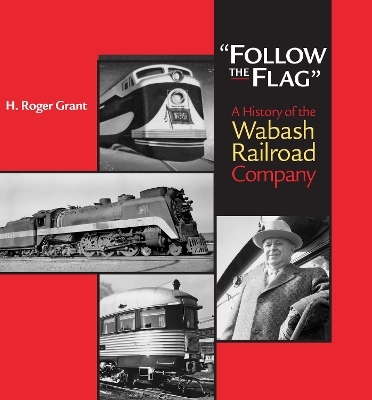
"Follow the Flag"
A History of the Wabash Railroad Company
Seiten
2019
Northern Illinois University Press (Verlag)
978-1-5017-4777-9 (ISBN)
Northern Illinois University Press (Verlag)
978-1-5017-4777-9 (ISBN)
"Follow the Flag" offers the first authoritative history of the Wabash Railroad Company, a once vital interregional carrier. The corporate saga of the Wabash involved the efforts of strong-willed and creative leaders, but this book provides more than traditional business history. Noted transportation historian H. Roger Grant captures the human side of the Wabash, ranging from the medical doctors who created an effective hospital department to the worker-sponsored social events. And Grant has not ignored the impact the Wabash had on businesses and communities in the "Heart of America."
Like most major American carriers, the Wabash grew out of an assortment of small firms, including the first railroad to operate in Illinois, the Northern Cross. Thanks in part to the genius of financier Jay Gould, by the early 1880s what was then known as the Wabash, St. Louis & Pacific Railway reached the principal gateways of Chicago, Des Moines, Detroit, Kansas City, and St. Louis. In the 1890s, the Wabash gained access to Buffalo and direct connections to Boston and New York City.
One extension, spearheaded by Gould's eldest son, George, fizzled. In 1904 entry into Pittsburgh caused financial turmoil, ultimately throwing the Wabash into receivership. A subsequent reorganization allowed the Wabash to become an important carrier during the go-go years of the 1920s and permitted the company to take control of a strategic "bridge" property, the Ann Arbor Railroad.
The Great Depression forced the company into another receivership, but an effective reorganization during the early days of World War II gave rise to a generally robust road. Its famed Blue Bird streamliner, introduced in 1950 between Chicago and St. Louis, became a widely recognized symbol of the "New Wabash." When "merger madness" swept the railroad industry in the 1960s, the Wabash, along with the Nickel Plate Road, joined the prosperous Norfolk & Western Railway, a merger that worked well for all three carriers.
Immortalized in the popular folk song "Wabash Cannonball," the midwestern railroad has left important legacies. Today, forty years after becoming a "fallen flag" carrier, key components of the former Wabash remain busy rail arteries and terminals, attesting to its historic value to American transportation.
Like most major American carriers, the Wabash grew out of an assortment of small firms, including the first railroad to operate in Illinois, the Northern Cross. Thanks in part to the genius of financier Jay Gould, by the early 1880s what was then known as the Wabash, St. Louis & Pacific Railway reached the principal gateways of Chicago, Des Moines, Detroit, Kansas City, and St. Louis. In the 1890s, the Wabash gained access to Buffalo and direct connections to Boston and New York City.
One extension, spearheaded by Gould's eldest son, George, fizzled. In 1904 entry into Pittsburgh caused financial turmoil, ultimately throwing the Wabash into receivership. A subsequent reorganization allowed the Wabash to become an important carrier during the go-go years of the 1920s and permitted the company to take control of a strategic "bridge" property, the Ann Arbor Railroad.
The Great Depression forced the company into another receivership, but an effective reorganization during the early days of World War II gave rise to a generally robust road. Its famed Blue Bird streamliner, introduced in 1950 between Chicago and St. Louis, became a widely recognized symbol of the "New Wabash." When "merger madness" swept the railroad industry in the 1960s, the Wabash, along with the Nickel Plate Road, joined the prosperous Norfolk & Western Railway, a merger that worked well for all three carriers.
Immortalized in the popular folk song "Wabash Cannonball," the midwestern railroad has left important legacies. Today, forty years after becoming a "fallen flag" carrier, key components of the former Wabash remain busy rail arteries and terminals, attesting to its historic value to American transportation.
H. Roger Grant is the Centennial Professor of History at Clemson University. One of America's leading railroad historians, he is author of numerous books on railroad history, including The North Western and The Corn Belt Route.
Table of Contents Preface Acknowledgments 1. The Wabash Emerges East of the Mississippi River 2. The Wabash Emerges West of the Mississippi River 3. The Jay Gould Years 4. The Wabash Matures 5. "Follow the Flag" 6. Reorganization, War, Boom, and Bust 7. Depression, Rebirth, and World War II 8. The New Wabash 9. A Fallen Flag Epilogue Notes Index
| Erscheinungsdatum | 17.09.2019 |
|---|---|
| Zusatzinfo | 86 Halftones, black and white |
| Sprache | englisch |
| Maße | 210 x 235 mm |
| Gewicht | 907 g |
| Themenwelt | Natur / Technik ► Fahrzeuge / Flugzeuge / Schiffe ► Schienenfahrzeuge |
| Geisteswissenschaften ► Geschichte ► Regional- / Ländergeschichte | |
| ISBN-10 | 1-5017-4777-0 / 1501747770 |
| ISBN-13 | 978-1-5017-4777-9 / 9781501747779 |
| Zustand | Neuware |
| Informationen gemäß Produktsicherheitsverordnung (GPSR) | |
| Haben Sie eine Frage zum Produkt? |
Mehr entdecken
aus dem Bereich
aus dem Bereich
Das Beste aus Stadt und Land.
Buch | Softcover (2024)
VUD Medien (Verlag)
12,00 €
The Definitive Guide
Buch | Softcover (2024)
hidden europe publications (Verlag)
26,15 €
die visuelle Chronik der Schienenfahrzeuge
Buch | Hardcover (2024)
DK Verlag Dorling Kindersley
34,95 €


